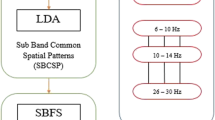Abstract
Mental tasks classification such as motor imagery, based on EEG signals is an important problem in brain computer interface systems (BCI). One of the major concerns in BCI is to have a high classification accuracy. The other concerning one is with the favorable result is guaranteed how to improve the computational efficiency. In this paper, Mu/Beta rhythm was obtained by bandpass filter from EEG signal. And the classical linear discriminant analysis (LDA) was used for deciding which rhythm can give the better classification performance. During this, the common spatial pattern (CSP) was used to project data subject to the ratio of projected energy of one class to that of the other class was maximized. The optimal projection dimension was determined corresponding to the maximum of area under the curve (AUC) for each participant. Eventually, regularized linear discriminant analysis (RLDA) is possible to decode the imagined motor sensed using electroencephalogram (EEG). Results show that higher classification accuracy can be provided by RLDA. And optimal projection dimensions determined by LDA and RLDA are of consistent solution, this improves computational efficiency of CSP-RLDA method without computation of projection dimension.









Similar content being viewed by others
References
Shi, T., Cui, W., and Ren, L., Multimedia remote interactive operations based on EEG signals constructed BCI with convolutional neural network. Multimed. Tools Appl.:1–15, 2019.
Burns, A., Adeli, H., and Buford, J. A., Brain-computer interface after nervous system injury. Neurosci. A Rev. J. Bringing Neurobiol. Neurol. Psych. 20(6):639–651, 2014.
Baxter, B. S., Edelman, B. J., Nesbitt, N., and He, B., Sensorimotor rhythm bci with simultaneous high definition-transcranial direct current stimulation alters task performance. Brain Stimul. 9(6):834–841, 2016.
Michalopoulos, K., Zervakis, M., Deiber, M. P., and Bourbakis, N., Classification of eeg single trial microstates using local global graphs and discrete hidden markov models. Int. J. Neural Syst. 26(6):1650036, 2016.
Wang, H., Chang, W., and Zhang, C., Functional brain network and multichannel analysis for the p300-based brain computer interface system of lying detection. Expert Syst. Appl. 53:117–128, 2016.
Kirar, J. S., and Agrawal, R. K., Relevant feature selection from a combination of spectral-temporal and spatial features for classification of motor imagery EEG. J. Med. Syst. 42(5):78, 2018.
Samuel, O. W., Geng, Y., Li, X., and Li, G., Towards efficient decoding of multiple classes of motor imagery limb movements based on EEG spectral and time domain descriptors. J. Med. Syst. 41(12):194, 2017.
Zhang, Y., Wang, Y., Jin, J., and Wang, X., Sparse bayesian learning for obtaining sparsity of eeg frequency bands based feature vectors in motor imagery classification. Int. J. Neural Syst. 27(2):1650032, 2017.
Li, X., Lu, X., and Wang, H., Robust common spatial +patterns with sparsity. Biomed. Sign. Proc. Con. 26:52–57, 2016.
Pfurtscheller, G., Brunner, C., Schlögl, A., and Fh, L. D. S., Mu rhythm (de)synchronization and eeg single-trial classification of different motor imagery tasks. Neuroimage 31(1):153–159, 2006.
Ye, J., Janardan, R., Li, Q., and Park, H., Feature reduction via generalized uncorrelated linear discriminant analysis. IEEE Trans. Knowl. Data Eng. 18(10):1312–1322, 2006.
Hatamikia, S., and Nasrabadi, A. M., Subject transfer bci based on composite local temporal correlation common spatial pattern. Comput. Biol. Med. 64:1–11, 2015.
Ramoser, H., Muller-Gerking, J., and Pfurtscheller, G., Optimal spatial filtering of single trial eeg during imagined hand movement. IEEE Trans. Rehab. Eng. A Publ. IEEE Eng. Med. Biol. Soc. 8(4):441–446, 2000.
Gutiérrez, D., and Salazar-Varas, R., Using eigenstructure decompositions of time-varying autoregressions in common spatial patterns-based eeg signal classification. Biomed. Sign. Proc. Con. 7(6):622–631, 2012.
Thomas, K. P., Guan, C., Lau, C. T., Vinod, A. P., and Kai, K. A., A new discriminative common spatial pattern method for motor imagery brain–computer interfaces. IEEE Trans. Biomed. Eng. 56(11):2730–2733, 2009.
Han, X., and Clemmensen, L., Regularized generalized eigen-decomposition with applications to sparse supervised feature extraction and sparse discriminant analysis. Pattern Recogn. 49:43–54, 2016.
Blankertz, B., Dornhege, G., Krauledat, M., Müller, K. R., and Curio, G., The non-invasive berlin brain-computer interface: Fast acquisition of effective performance in untrained subjects. Neuroimage 37(2):539–550, 2007.
Ji, S., and Ye, J., Kernel uncorrelated and regularized discriminant analysis: A theoretical and computational study. IEEE Trans. Knowl. Data Eng. 20(10):1311–1321, 2008.
Friedman, J. H., Regularized discriminant analysis. J. Am. Stat. Assoc. 84(405):165–175, 1989.
Fu, R., Wang, H., and Zhao, W., Dynamic driver fatigue detection using hidden markov model in real driving condition. Expert Syst. Appl. 63:397–411, 2016.
Acknowledgements
This work was supported by the National Natural Science Foundation of China (Grant No. 51605419, 51475407), Natural Science Foundation of Hebei Province (Grant No. E2018203433), China Postdoctoral Science Foundation (Grant No. 2016 M600193), Hebei Province Funding Project for Returned Overseas Scholar (Grant No. CL201727).
Funding
National Natural Science Foundation of China (Grant No. 51605419, 51475407), Natural Science Foundation of Hebei Province (Grant No. E2018203433), China Postdoctoral Science Foundation (Grant No. 2016 M600193), Hebei Province Funding Project for Returned Overseas Scholar (Grant No. CL201727).
Author information
Authors and Affiliations
Corresponding author
Ethics declarations
Conflict of Interest
The authors declare that they have no conflict of interest.
Clarification and Statement
This manuscript by Rongrong Fu, Yongsheng Tian, Tiantian Bao, Zong Meng, Peiming Shi titled “Improvement Motor Imagery EEG Classification based on Regularized Linear Discriminant Analysis” is an original unpublished work and the manuscript or any variation of it has not been submitted to any other publication previously. All of the authors have agreed with the submission.
Additional information
Publisher’s Note
Springer Nature remains neutral with regard to jurisdictional claims in published maps and institutional affiliations.
This article is part of the Topical Collection on Image & Signal Processing
Rights and permissions
About this article
Cite this article
Fu, R., Tian, Y., Bao, T. et al. Improvement Motor Imagery EEG Classification Based on Regularized Linear Discriminant Analysis. J Med Syst 43, 169 (2019). https://doi.org/10.1007/s10916-019-1270-0
Received:
Accepted:
Published:
DOI: https://doi.org/10.1007/s10916-019-1270-0




